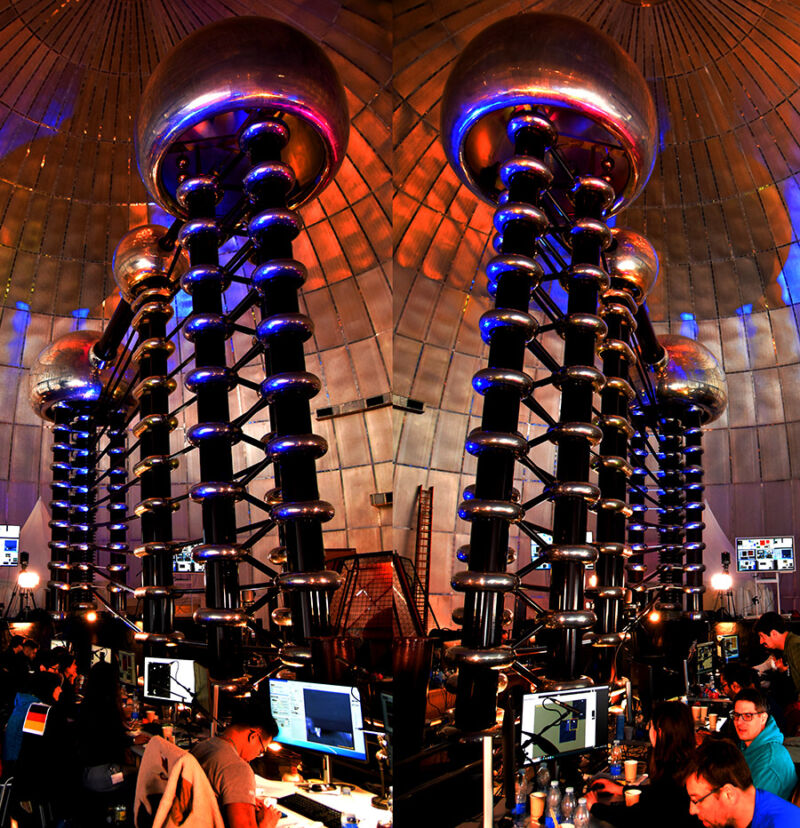

Not quite Le Mans: 24-hour race won by molecule that traveled 1 micron
source link: https://arstechnica.com/science/2022/04/not-quite-le-mans-24-hour-race-won-by-molecule-that-traveled-1-micron/
Go to the source link to view the article. You can view the picture content, updated content and better typesetting reading experience. If the link is broken, please click the button below to view the snapshot at that time.
No crashes occurred —
Not quite Le Mans: 24-hour race won by molecule that traveled 1 micron
A gold-plated racetrack and fuel from a scanning tunneling microscope.
Dhananjay Khadilkar - 4/20/2022, 11:00 AM

C64H22CuF6N4: it is both a chemical formula and the technical specification of a car that won the 24-hour race held recently in France. No, not the one in Le Mans. This particular event, Nanocar Race II—dubbed “the race of the smallest cars in the world”—was held in Toulouse, with eight teams fielding cars of nanometric dimensions.
Each car was essentially a molecule. The race-winning C64H22CuF6N4 molecule, measuring three nanometers in length and one nanometer in width, traveled a distance of one micron (1 millionth of a meter) in 24 hours, the longest distance in the competition.
The car was developed by the NIMS-MANA team from Tsukuba, Japan. Jonathan Hill, the team’s constructor leader, was pleasantly surprised by the result. “We hadn’t done so well in the first edition of the race in 2017. We didn’t expect to finish in the top three this time,” Hill told Ars Technica.
The second edition of the Nanocar Race took place from March 24 to March 25. Each of the eight cars was a complex molecule comprising between around 100 to 1,000 or so atoms with discernible front and rear sections. “We made 10 different molecules specifically for the race, out of which three turned out to be useful. We zeroed in on our 97-atom molecule challenger based on its ability to slide efficiently on the race track,” Hill said.
The race track consisted of zig-zag lines four to six nanometers wide on a gold surface. Gold was the preferred choice as these lines are generated by heat treatment of the gold surface.
Each car was propelled by a gentle electric pulse generated at the tip of a scanning tunneling microscope (STM). “The car, which is a large flat molecule, has a dipole moment [an uneven electrical charge due to its bonds]. When you bring the STM tip close to it, the electrical field causes the car to move due to repulsive interaction,” Hill said.
Advertisement
Each movement of the car consisted of a displacement of a few hundred picometers. The STM was also used to scan and image the position of the car as it moved along the surface, which was maintained at 5 Kelvin or -268° C in a vacuum.
The cars, present at the respective facilities of the eight participating teams, were remotely controlled from the race venue in Toulouse. According to race director Christian Joachim, it took two months of work and 1.5 kilometers of cabling (Ethernet, HDMI, power) to ensure the eight participants could operate their cars via the Internet. “We also took additional measures to ensure the network was secured from hacking for each team,” Joachim said.
Hill said that the vehicle was piloted by his teammate Shigeki Kawai for the entire duration of the race. “The other three team members had to do a lot of data processing as we had to collect images and process them to illustrate how far the car had moved.”
Along with its unique vehicles, what made the race special was the venue, a giant spherical structure called La Boule. Located in the CEMES (Centre d’Élaboration de Matériaux et d’Etudes Structurales) campus, it has a diameter of 25 meters and housed the world’s largest electron microscope at the beginning of the 1960s. “NIMS is famous for electron microscopy. We have many transmission electron microscopes. To visit the building that housed the biggest TEM was fascinating,” Hill said. For Joachim, La Boule was symbolic of the coming together of the past and the future of tracking atoms.
The NIMS-MANA team car, which traveled 1,054 nm in a closed circuit, shared the first prize with the Spanish team NANOHISPA from Madrid, whose car traveled 678 nanometers along a single trajectory and completed 54 turns, thereby covering the largest track area.
According to Hill, beyond the competition, they participated in the race because it helps us understand how molecules move, interact with the surface, or interact with each other is important for the area of molecular machines. “The developers of molecular machine technology won the 2016 Chemistry Nobel,” he pointed out. He said that molecules similar to their car, might ultimately be used for making liquid crystals and organic semiconductors.
Dhananjay Khadilkar is a journalist based in Paris.
Promoted Comments
-
DovePig Wise, Aged Ars Veteranjump to postrojcowles wrote:Very cool! (in all senses I guess)You are joking, but their final rankings table is actually pretty funny in itself
Now I'm imagining race commentary in the classic TV style though I imagine the odds of the Nanocar race ever being broadcast on live TV is slim.
"And C64H22CuF6N4 is lining up to enter turn 5, we'll be back in 15 minutes to see how it goes. Over to you Barry!"
"Thank you John, over at turn 26 the SPARC molecule is trying to overtake by quantum tunneling through the next turn, which might be against the rules"
"Actually Barry that's probably a violation of the laws of physics"
INCIDENTS:
1. Changing lane for overpassing - Crash at 5.30pm
1. Cross a trench and go back - jump across a trench *8
3. Cross a trench *3
4. Cross a trench *2, crash
5. Molecule jump onto the tip
6. Molecule is lost again
7. Corss a trench *2, one wheel
Poor team in the sixth place, though – and they were the home team
Recommend
About Joyk
Aggregate valuable and interesting links.
Joyk means Joy of geeK